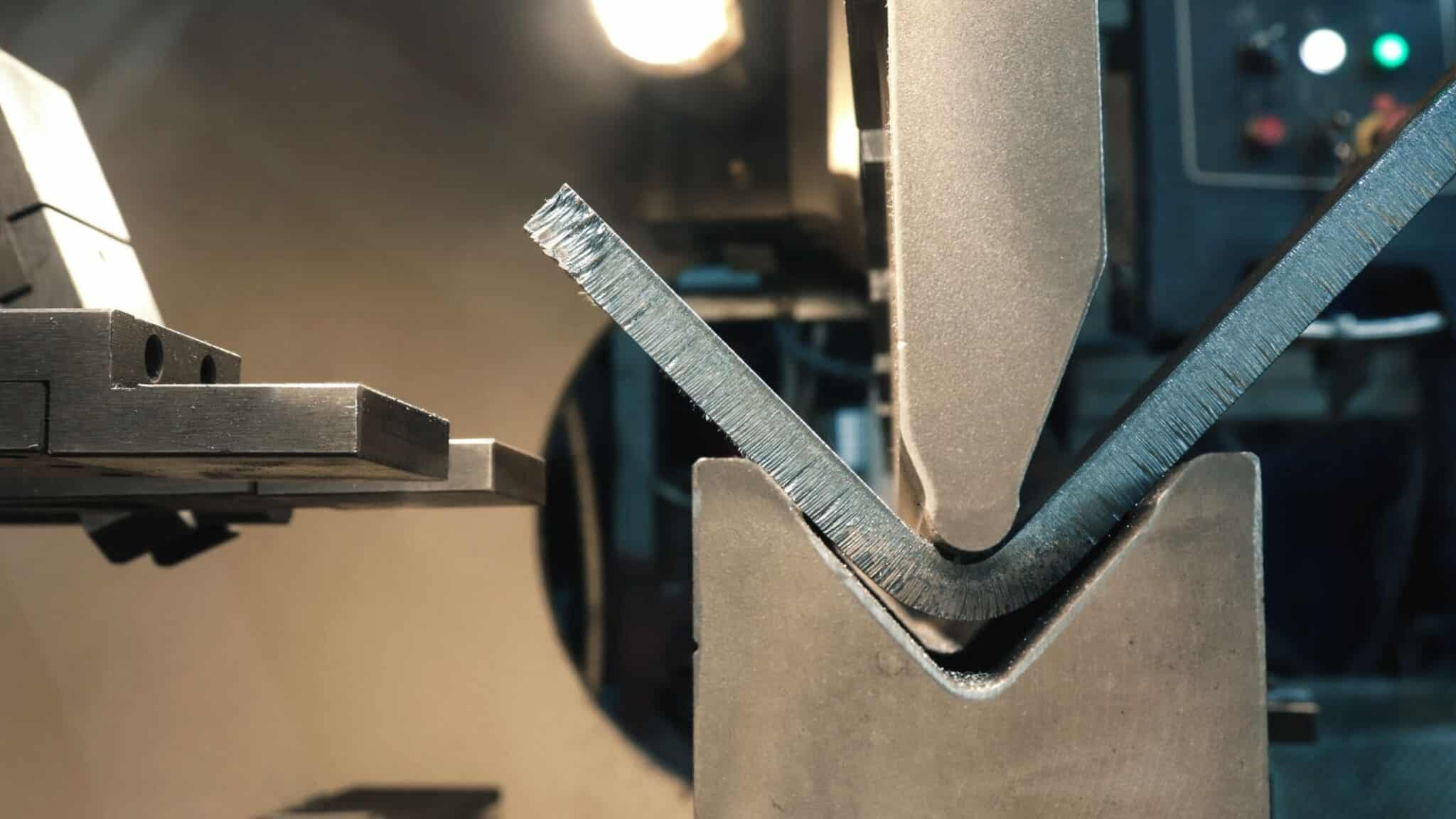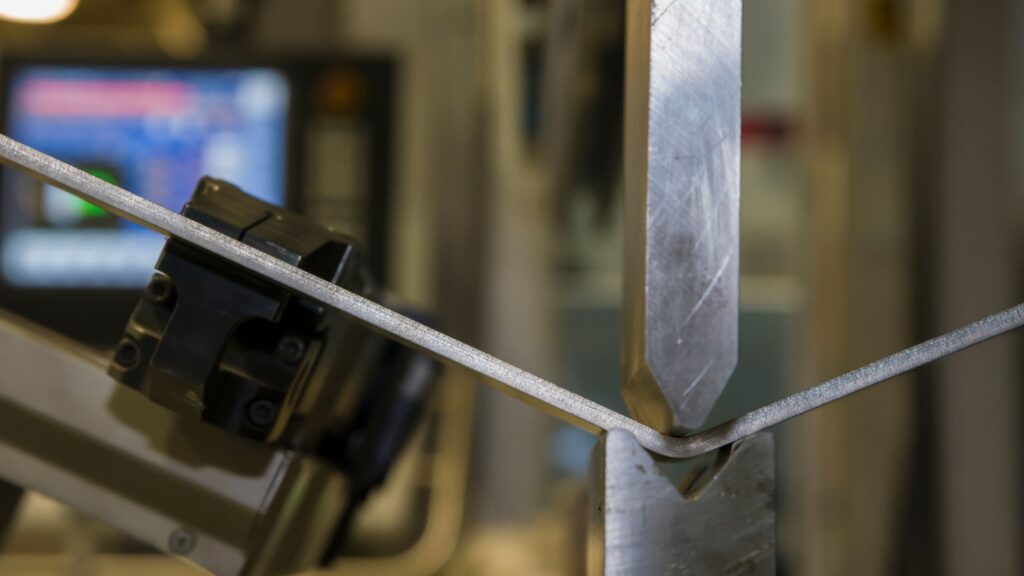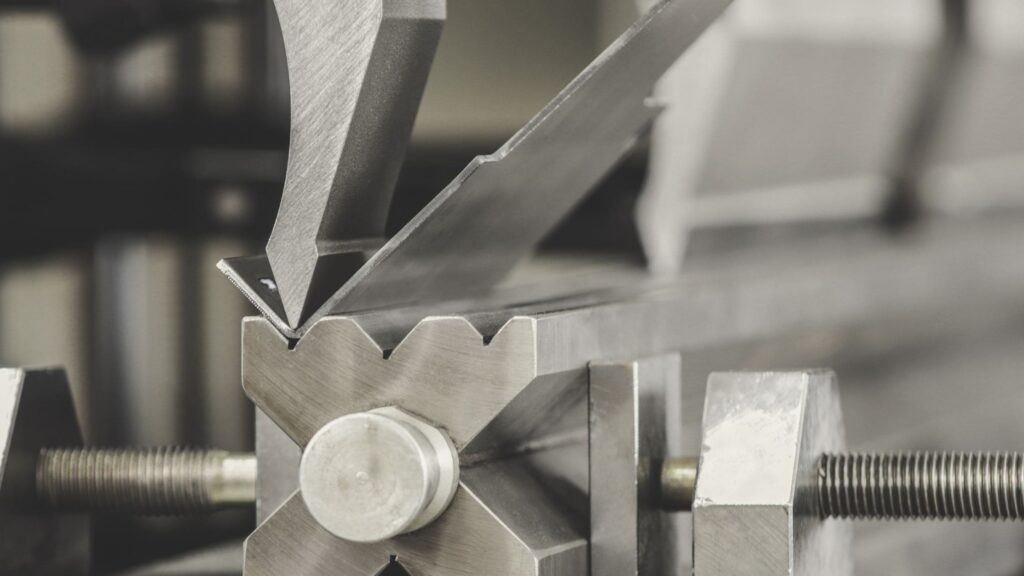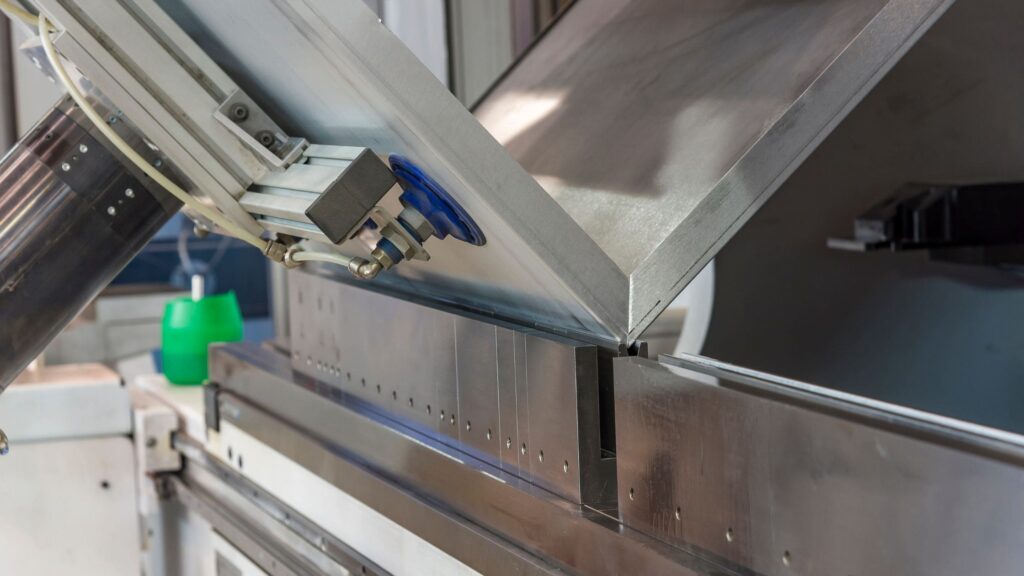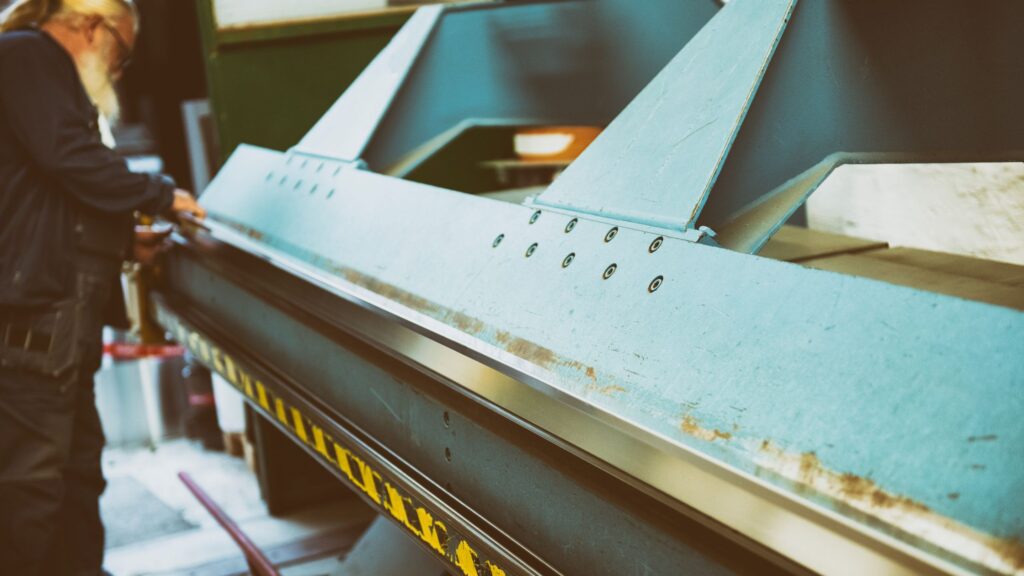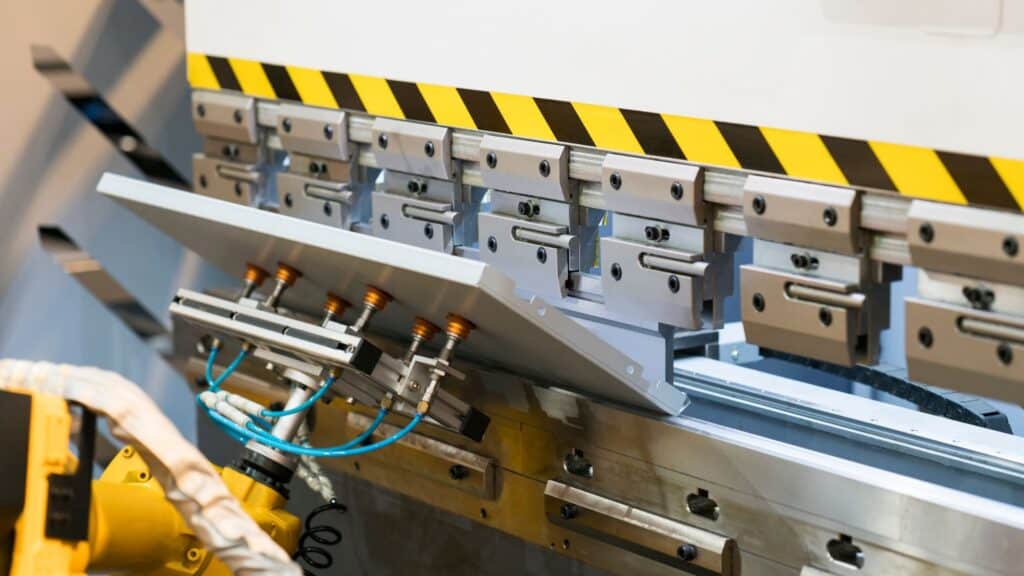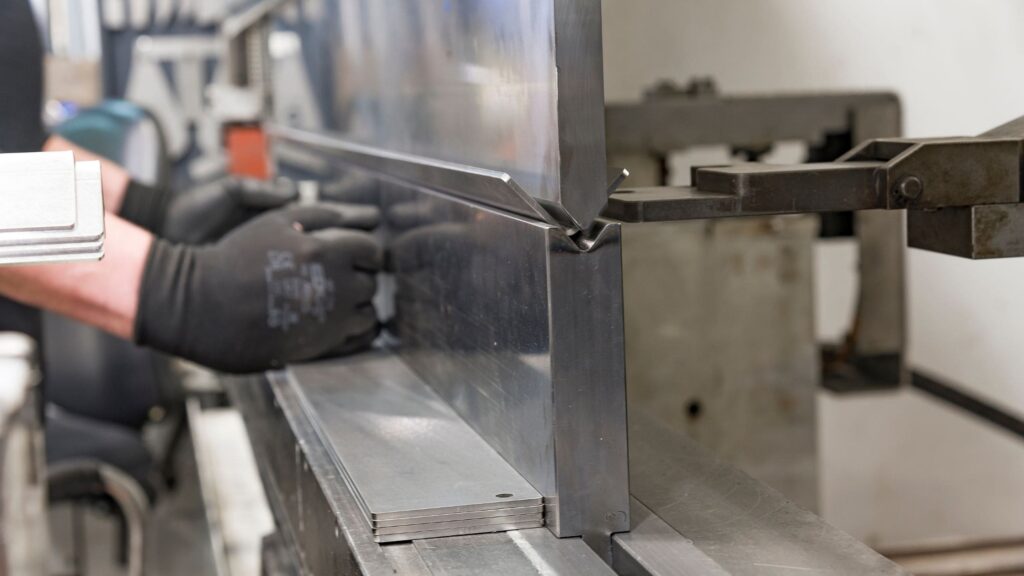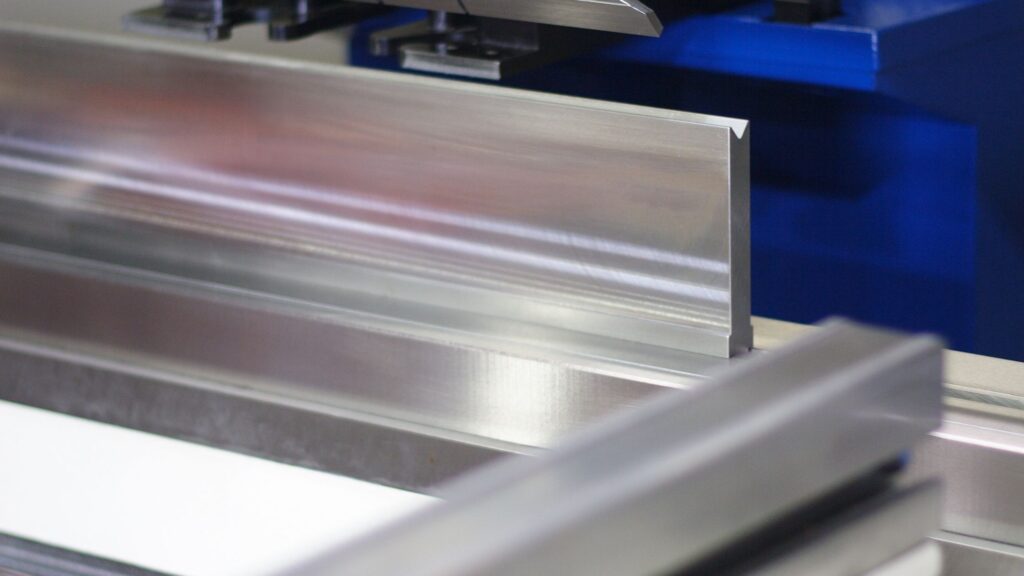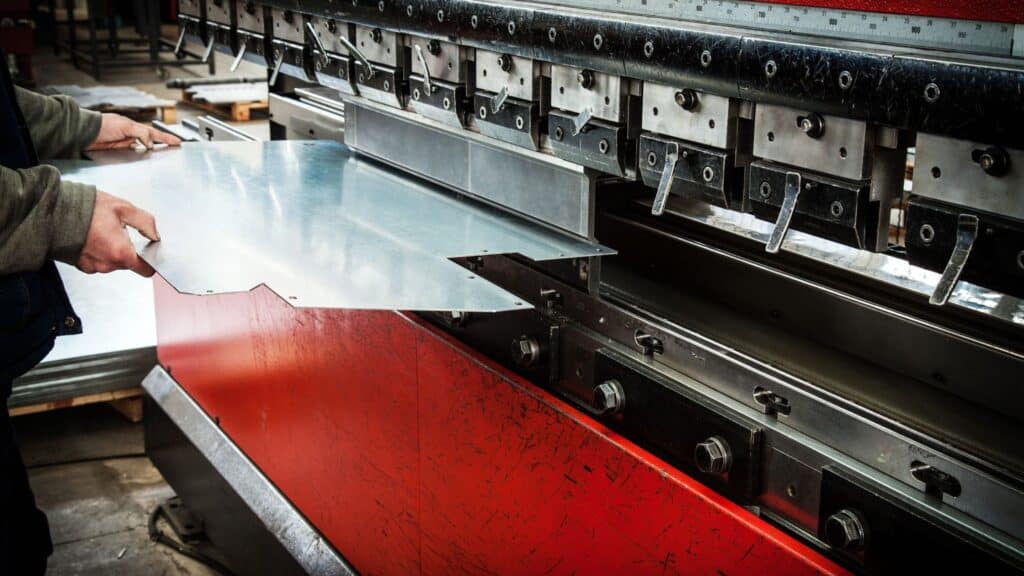Metal bending isn’t just limited to the metalworking industry alone, but also the automotive and construction world. Its application ranges from electronic casings to the manufacturing of vehicle body panels.
Understanding how metal bending works will improve your metal fabrication skills.
This article will focus on the different metal bending types, their unique applications, and advantages and disadvantages.
What is Metal Bending?
Metal bending is a fundamental process in metalworking that involves deforming metal into a desired shape by applying force. This technique is essential in fabricating various metal components and structures. The process typically utilizes press brakes, bending machines, and specific tools such as punches and dies to achieve precise bends. Metal bending techniques, including air bending, bottom bending, and coining, are used to form sheet metal into complex shapes with exact bend angles and radii. The accuracy and consistency of metal bending make it indispensable in manufacturing industries.
Why Is Metal Bending Essential in Manufacturing?
Metal bending plays a crucial role in manufacturing due to its versatility and efficiency. It allows for the creation of a wide range of components, from simple brackets to complex enclosures, making it a key process in industries such as automotive, aerospace, construction, and electronics. The ability to bend sheet metal into precise shapes reduces the need for multiple parts and joints, enhancing the structural integrity and durability of the final product. Additionally, metal bending minimizes material wastage and lowers production costs, contributing to more sustainable manufacturing practices.
How Does the Metal Bending Process Work?
Metal bending involves several crucial steps to transform sheet metal into specific shapes. The process begins with calculating the design parameters, followed by setting up the equipment. The material is then aligned, and the bending tool is engaged to apply the necessary force. Finally, the results are verified to ensure precision and accuracy.
Calculate the Design Parameters
The first step in metal bending is calculating the design parameters, which include the bend radius, bend angle, and material thickness. These parameters determine the force required and the tooling setup. Accurate calculations are essential to achieve the desired bend without causing defects like cracking or springback. Tools like CNC software and design simulations are often used to refine these parameters and ensure they meet the project specifications.
Set Up the Equipment
Once the design parameters are established, the next step is setting up the equipment. This involves selecting the appropriate press brake, bending machines, or other tools based on the material and bending technique. For instance, a press brake tool is used for air bending and bottom bending, while roll bending machines are used for forming curved shapes. Proper tool setup, including adjusting die shoulders and punch tips, is crucial to maintain precision. The equipment must be calibrated to apply the correct force and stroke depth, ensuring consistent results across multiple workpieces.
Align the Material
Aligning the material is a crucial step in the metal bending process. The sheet metal must be positioned correctly on the press brake or bending machine to ensure accurate bends. This alignment involves placing the metal sheet against back gauges or stops, which help maintain consistency across multiple bends. Proper alignment reduces errors and ensures that the bend angles and radii meet the design specifications. Depending on the complexity of the bend, additional fixtures or clamps may be used to hold the material in place during the bending process.
Engage the Bending Tool
Engaging the bending tool is the next step after aligning the material. This involves activating the press brake or bending machine to apply force to the sheet metal. The bending tool, typically consisting of a punch and die, shapes the metal by pressing it into the desired form. Various types of metal bending techniques, such as air bending, bottom bending, and coining, can be used depending on the required bend angles and material thickness. Each technique utilizes different tools and methods to achieve precise bends. For example, air bending allows for flexibility in bend angles, while bottom bending provides more accuracy and repeatability.
Verify the Results
After the bending tool has been engaged, it is essential to verify the results. This step ensures that the bends meet the required specifications and tolerances. Measurements such as bend angle, bend radius, and overall dimensions are checked using precision tools like calipers and protractors. Any deviations from the design parameters must be addressed through adjustments to the bending process or equipment setup. Verifying the results ensures the quality and consistency of the final product, reducing the need for rework and ensuring that the metal parts are ready for subsequent manufacturing steps or assembly.
What are the Different Types of Metal Bending?
Metal bending is an essential technique in metalworking used to shape sheet metal into desired forms. Various types of metal bending methods exist, each suited to different applications and offering distinct advantages and disadvantages. The primary metal bending techniques include air bending, bottom bending, and coining, among others. Each method involves specific tools and processes to achieve precise bends in metal sheets.
Air Bending
Air bending is a versatile and widely used metal bending technique that employs a punch and die to form a bend. In air bending, the punch does not fully press the sheet metal into the die, allowing for flexibility in achieving various bend angles by adjusting the stroke depth.
Pros:
- Allows for different bend angles with the same tooling
- Requires less force compared to other bending methods
- Reduces wear on tools
Cons:
- Less precise than bottom bending and coining
- Higher springback, requiring adjustments
Common Applications:
- Fabrication of lightweight brackets and frames
- Production of automotive body panels
- Manufacturing of electrical enclosures
Bottom Bending
Bottom bending, also known as bottoming, is a technique where the punch presses the sheet metal fully into the die, resulting in a precise bend with minimal springback. This method provides higher accuracy and repeatability, making it suitable for applications requiring tight tolerances.
Pros:
- High precision and repeatability
- Minimal springback
- Suitable for tight tolerances
Cons:
- Requires more force than air bending
- Increased tool wear
Common Applications:
- Precision parts in aerospace and automotive industries
- Fabrication of metal components for medical devices
- Production of structural metal parts
Coining
Coining is a precision metal bending technique where the punch fully presses the sheet metal into the die, creating a sharp and accurate bend. This method minimizes springback, ensuring that the bend angle remains consistent. Coining requires high force, making it suitable for applications requiring tight tolerances and exact bends.
Pros:
- High precision
- Minimal springback
- Suitable for tight tolerances
Cons:
- Requires high force
- Increased tool wear
Common Applications:
- Aerospace components requiring high accuracy
- Medical devices with precise dimensions
- Automotive parts where tight tolerances are critical
Folding
Folding involves clamping the sheet metal and bending it using a tool that applies pressure along a straight line. This technique is ideal for creating long, straight bends in large sheets of metal. Folding is commonly used in the fabrication of panels and enclosures.
Pros:
- Suitable for long, straight bends
- Ideal for large sheet metal pieces
- Versatile for different materials
Cons:
- Limited to straight bends
- May require specialized equipment
Common Applications:
- Manufacturing of metal cabinets and enclosures
- Fabrication of HVAC ductwork
- Construction of metal panels and roofing
Wiping
Wiping, also known as wipe bending, is a technique where the sheet metal is clamped in place, and a punch moves across the material to bend it over a wiping die. This method is effective for creating precise and consistent bends, especially when dealing with smaller bend angles.
Pros:
- High precision
- Suitable for small bend angles
- Consistent results
Cons:
- Limited to specific bend angles
- May require special tooling
Common Applications:
- Automotive panels
- Metal brackets
- Enclosures and housings
Joggling
Joggling is a bending technique used to create offset bends in sheet metal. This method involves forming two bends in opposite directions close to each other, resulting in a step-like offset. Joggling is essential when parts need to fit together without interference.
Pros:
- Creates precise offsets
- Ideal for assembly applications
- Enhances structural integrity
Cons:
- Requires precise tooling
- Can be complex to set up
Common Applications:
- Aerospace components
- Sheet metal assemblies
- HVAC ductwork
Rolling
Rolling is a metal bending technique that involves passing sheet metal through rollers to achieve a curved shape. The process uses three rollers positioned in a pyramid shape. As the sheet metal passes between the rollers, it bends incrementally to form a precise curve. Rolling is ideal for creating large radius bends and cylindrical shapes.
Pros:
- Suitable for large radius bends
- Produces consistent and smooth curves
- Capable of handling large sheets
Cons:
- Limited to specific curve shapes
- Requires significant setup and calibration
Common Applications:
- Fabrication of cylindrical tanks
- Production of large-diameter pipes
- Manufacturing of curved structural components
Tube Bending
Tube bending is a technique specifically designed for shaping metal tubes and pipes. This process uses various methods such as compression bending, rotary draw bending, and roll bending to achieve precise bends without compromising the integrity of the tube. Tube bending is essential for creating complex shapes and angles in tubing used in various industries.
Pros:
- Creates precise bends
- Maintains structural integrity of the tube
- Suitable for various tube diameters and materials
Cons:
- Requires specialized equipment
- Higher complexity in setup and execution
Common Applications:
- Automotive exhaust systems
- Plumbing and HVAC installations
- Frames and structural components in aerospace and marine industries
Rotary Bending
Rotary bending, also known as rotary draw bending, involves a rotating die to bend the metal around a fixed radius. This method is highly precise and is commonly used for creating tight-radius bends. The process is ideal for bending tubes and rods with minimal distortion and high repeatability.
Pros:
- High precision and repeatability
- Suitable for tight-radius bends
- Minimizes material distortion
Cons:
- Limited to specific bend radii
- Requires precise setup and tooling
Common Applications:
- Bending tubes for hydraulic and fuel systems
- Manufacturing of handrails and guardrails
- Fabrication of custom metal parts for machinery and equipment
Three-Point Bending
Three-point bending is a technique where the sheet metal is supported at two points and a force is applied at a third point in the middle to create the bend. This method is widely used for its simplicity and effectiveness in producing precise bends.
Pros:
- Simple setup
- Precise control over bend angle
- Suitable for various material thicknesses
Cons:
- Limited to specific bend angles
- May require higher force for thicker materials
Common Applications:
- Structural components in construction
- Manufacturing of beams and girders
- Producing parts for automotive and aerospace industries
Elastomer Bending
Elastomer bending involves using a flexible, rubber-like material to assist in the bending process. This technique is effective for creating complex shapes and protecting the surface of the metal during bending.
Pros:
- Reduces surface damage
- Suitable for complex shapes
- Can accommodate various material thicknesses
Cons:
- Requires specialized elastomer tooling
- May have limitations in bend angles
Common Applications:
- Production of custom metal parts
- Manufacturing of components requiring smooth surfaces
- Fabrication of parts with intricate designs
What Are Advanced Metal Bending Techniques?
In the world of metal bending, advanced techniques are continuously being developed to enhance precision, efficiency, and versatility. Two notable methods are laser-assisted bending and CNC bending. These techniques leverage modern technology to achieve intricate bends with high accuracy, catering to complex shapes and specific material properties.
Laser-Assisted Bending
Laser-assisted bending uses a laser beam to preheat the metal along the intended bend line, reducing the force required to bend the material. This technique is especially useful for bending high-strength materials and achieving precise bend angles.
Pros:
- Reduces bending force
- Increases precision
- Minimizes material springback
Cons:
- High initial setup cost
- Requires specialized equipment and training
Common Applications:
- Aerospace components
- Automotive parts
- Precision instruments
- Complex geometries in industrial design
CNC Bending
CNC (Computer Numerical Control) bending involves the use of automated machines controlled by computer programs to perform precise and repeatable bends. This method is highly efficient and suitable for mass production.
Pros:
- High precision and repeatability
- Suitable for mass production
- Reduces manual labor
Cons:
- High initial investment
- Requires skilled programming and setup
Common Applications:
- Sheet metal fabrication
- Electrical enclosures
- Automotive chassis parts
- Structural components
What Are the Important Parameters in Metal Bending?
When dealing with metal bending, certain parameters are crucial for achieving precision and desired results. The three most important parameters are bend radius, bend angle, and material thickness.
- Bend Radius: It refers to the inside curvature of a bend. It is critical because it determines the structural integrity and appearance of the bend. A smaller bend radius can result in cracks or deformation, while a larger radius might not achieve the desired shape. This parameter is measured in millimeters or inches and is essential in ensuring the material’s bendability and final product quality.
- Bend Angle: Indicates the angle to which the metal is bent. This is crucial for achieving the desired shape and fit of the workpiece. The bend angle affects the overall dimensions and alignment of the metal parts. It is measured in degrees, and precise control over this parameter ensures consistency and accuracy in the final product.
- Material Thickness: This is the thickness of the metal sheet being bent. This parameter influences the force required for bending and the bend radius. Thicker materials need more force and have larger bend radii, affecting the final geometry and structural properties. Material thickness is measured in millimeters or gauge.
- Bend Allowance: This is the material length required to form a bend. It accounts for the stretch of the material during bending and is essential for accurate part dimensions. It is measured in millimeters or inches.
- Bend Deduction: This parameter represents the difference between the total length of the bent part and the sum of the outside dimensions. It helps in calculating the flat pattern layout for bending processes. Bend deduction is also measured in millimeters or inches.
- K-Factor: The K-factor is the ratio of the neutral axis to the material thickness. It helps in predicting the material stretch during bending. The K-factor is unitless but is essential for precise bending calculations.
- Tensile Strength: This is the maximum stress the material can withstand while being stretched or pulled before breaking. It is crucial for determining the material’s ability to withstand bending without fracturing. Tensile strength is measured in megapascals (MPa).
- Yield Strength: This is the stress at which a material begins to deform plastically. Knowing the yield strength helps in selecting the appropriate materials and avoiding permanent deformation during bending. Yield strength is measured in megapascals (MPa).
- Springback: Springback is the tendency of metal to partially return to its original shape after bending. It must be compensated for during the bending process to achieve the correct bend angle. It is usually expressed as a percentage.
- Inside Bend Radius: This is the radius on the inner side of the bend and directly influences the bend quality and material stretch. It is measured in millimeters or inches.
- Neutral Axis: The neutral axis is an imaginary line in the material where there is no tensile or compressive stress during bending. It is important for accurate bend calculations and is located at a specific distance from the material surface.
- Friction: Friction between the metal and the bending tools can affect the bending process, influencing force requirements and bend quality. It is typically considered in the selection of lubricants and tool materials.
What Metals Are Suitable for Metal Bending?
In metal bending, selecting the right type of metal is crucial for achieving desired shapes and ensuring structural integrity. The main metals commonly used in metal bending include mild steel (carbon steel) and stainless steel.
Mild Steel (Carbon Steel)
Mild steel, also known as carbon steel, is highly suitable for metal bending due to its ductility and malleability. It is widely used in construction and manufacturing because of its ability to withstand deformation without breaking.
Properties of Mild Steel:
- Yield Strength (MPa): 250-350
- Tensile Strength (MPa): 370-700
- Hardness (Brinell): 120-180
Main Grades Used:
- A36: Known for its excellent weldability and machinability.
- 1018: Offers a good balance of strength and ductility.
- 1045: High strength and hardness, suitable for high-stress applications.
Common Applications:
- Structural components
- Machinery parts
- Automotive frames
Stainless Steel
Stainless steel is preferred for applications requiring corrosion resistance and high strength. Its unique properties make it ideal for use in harsh environments and high-temperature applications.
Properties of Stainless Steel:
- Yield Strength (MPa): 200-250
- Tensile Strength (MPa): 500-700
- Hardness (Brinell): 160-190
Main Grades Used:
- 304: General-purpose grade with good corrosion resistance.
- 316: Enhanced corrosion resistance, suitable for marine environments.
- 430: Offers good formability and oxidation resistance.
Common Applications:
- Food processing equipment
- Chemical containers
- Medical instruments
Aluminum
Aluminum is widely used in metal bending because of its excellent properties. It is lightweight, corrosion-resistant, and easy to work with, making it ideal for various applications.
Main Grades Used:
- 6061: Known for its good mechanical properties and weldability.
- 5052: Offers excellent corrosion resistance and is highly formable.
- 3003: Provides good workability and is highly resistant to corrosion.
Properties of Aluminum:
- Yield Strength (MPa): 55-145
- Tensile Strength (MPa): 90-170
- Hardness (Brinell): 30-95
Common Applications:
- Aerospace components
- Automotive parts
- Construction materials
Brass
Brass is another metal suitable for bending due to its excellent machinability and corrosion resistance. It is often used in decorative applications and electrical components.
Main Grades Used:
- C36000 (Free-Cutting Brass): Known for its high machinability.
- C26000 (Cartridge Brass): Offers good corrosion resistance and strength.
- C28000 (Muntz Metal): Provides high strength and corrosion resistance.
Properties of Brass:
- Yield Strength (MPa): 125-250
- Tensile Strength (MPa): 300-400
- Hardness (Brinell): 60-100
Common Applications:
- Plumbing fittings
- Musical instruments
- Electrical connectors
Copper
Copper is highly suitable for metal bending because of its excellent ductility and conductivity. It is often used in applications where electrical conductivity and corrosion resistance are required.
Main Grades Used:
- C11000 (Electrolytic Tough Pitch Copper): Known for its high conductivity and corrosion resistance.
- C10100 (Oxygen-Free Copper): Offers superior ductility and purity.
- C12200 (Phosphorus-Deoxidized Copper): Known for its excellent welding and brazing properties.
Properties of Copper:
- Yield Strength (MPa): 69-210
- Tensile Strength (MPa): 210-350
- Hardness (Brinell): 45-110
Common Applications:
- Electrical wiring
- Plumbing fixtures
- Decorative elements
Galvanized Steel
Galvanized steel is another popular choice for metal bending due to its enhanced corrosion resistance, achieved through a zinc coating. It is widely used in construction and industrial applications.
Main Grades Used:
- ASTM A653: Standard specification for steel sheet, zinc-coated (galvanized) by the hot-dip process.
- G90: Indicates the thickness of the zinc coating, providing high corrosion resistance.
- G60: A lighter zinc coating, used for applications with less exposure to corrosive elements.
Properties of Galvanized Steel:
- Yield Strength (MPa): 230-550
- Tensile Strength (MPa): 270-650
- Hardness (Brinell): 50-95
Common Applications:
- Roofing and siding
- Automotive parts
- Outdoor structures
Titanium
Titanium is highly suitable for metal bending due to its excellent strength-to-weight ratio and corrosion resistance. This metal is often used in aerospace, medical, and industrial applications where high performance is required.
Main Grades Used:
- Grade 1: Known for its excellent corrosion resistance and ductility.
- Grade 2: Offers a balance of strength and ductility, making it versatile.
- Grade 5 (Ti-6Al-4V): The most commonly used titanium alloy, known for its high strength and lightweight properties.
Properties of Titanium:
- Yield Strength (MPa): 240-1100
- Tensile Strength (MPa): 345-1200
- Hardness (Rockwell C): 20-40
Common Applications:
- Aircraft components
- Medical implants
- Chemical processing equipment
Nickel Alloys
Nickel alloys are favored for metal bending due to their excellent heat resistance and corrosion resistance. These alloys are commonly used in high-temperature and high-stress environments.
Main Grades Used:
- Inconel 625: Known for its excellent fatigue and thermal-fatigue properties.
- Monel 400: Offers good corrosion resistance and moderate strength.
- Hastelloy C276: Notable for its high resistance to pitting and crevice corrosion.
Properties of Nickel Alloys:
- Yield Strength (MPa): 240-800
- Tensile Strength (MPa): 550-1000
- Hardness (Brinell): 135-240
Common Applications:
- Gas turbine components
- Chemical processing equipment
- Marine engineering
Platinum
Platinum is highly suitable for metal bending due to its exceptional ductility and resistance to corrosion. This metal is often used in high-end applications, including jewelry, laboratory equipment, and medical devices.
Main Grades Used:
- Pt950: Contains 95% platinum and 5% other metals.
- Pt900: Contains 90% platinum and 10% other metals.
Properties of Platinum:
- Yield Strength (MPa): 110-150
- Tensile Strength (MPa): 200-250
- Hardness (Vickers): 40-50
Common Applications:
- High-end jewelry
- Laboratory equipment
- Medical devices
Zinc
Zinc is another metal that is well-suited for bending due to its malleability and low melting point. It is commonly used in construction, automotive parts, and various other applications.
Main Grades Used:
- Zamak 3: Contains 96% zinc, with aluminum, magnesium, and copper.
- Zamak 5: Similar to Zamak 3 but with higher copper content for added strength.
Properties of Zinc:
- Yield Strength (MPa): 150-180
- Tensile Strength (MPa): 250-300
- Hardness (Vickers): 80-100
Common Applications:
- Construction materials
- Automotive parts
- Household items
Tin
Tin is a versatile metal known for its excellent formability and low melting point, making it suitable for various bending processes. It is commonly used in electronics, food packaging, and soldering applications.
Main Grades Used:
- Commercial Grade Tin (99.85% pure): Used in general applications.
- High Purity Tin (99.99% pure): Used in high-tech and specialized applications.
Properties of Tin:
- Yield Strength (MPa): 15-25
- Tensile Strength (MPa): 25-35
- Hardness (Vickers): 5-10
Common Applications:
- Electronics components
- Food packaging
- Soldering
Lead
Lead is another metal that is well-suited for bending due to its high malleability and density. It is often used in construction, radiation shielding, and batteries.
Main Grades Used:
- Pure Lead (99.9% pure): Used in radiation shielding and industrial applications.
- Lead Alloys: Containing tin or antimony for added strength and hardness.
Properties of Lead:
- Yield Strength (MPa): 5-20
- Tensile Strength (MPa): 10-25
- Hardness (Vickers): 4-10
Common Applications:
- Radiation shielding
- Construction materials
- Batteries
Inconel
Inconel is renowned for its high strength, excellent corrosion resistance, and ability to withstand extreme temperatures. These properties make it ideal for applications in aerospace, chemical processing, and marine environments.
Main Grades Used:
- Inconel 625: Known for its high strength and excellent fabricability.
- Inconel 718: Offers high yield, tensile, and creep-rupture properties at high temperatures.
Properties of Inconel:
- Yield Strength (MPa): 460-1100
- Tensile Strength (MPa): 930-1400
- Hardness (Rockwell C): 30-40
Common Applications:
- Aerospace engine components
- Chemical processing equipment
- Marine hardware
How to Choose the Right Material for Metal Bending
Choosing the right material for metal bending involves understanding the properties of different metals and how they affect the bending process. Here’s a guide to help you make informed decisions.
- Identify the Application:
- Determine the environment (e.g., marine, aerospace, industrial).
- Assess the required mechanical properties (e.g., strength, flexibility).
- Evaluate Material Properties:
- Malleability: Choose materials that can be easily bent, such as aluminum or copper, for simple applications.
- Strength and Durability: For heavy-duty applications, consider metals like titanium or Inconel.
- Corrosion Resistance: Use stainless steel or Inconel in corrosive environments.
- Consider the Bending Process:
- Press Brake Bending: Suitable for thicker materials like stainless steel.
- Air Bending: Good for various metals but requires precise control of bend angles.
- Roll Bending: Ideal for creating large, smooth curves in metals like aluminum or steel.
- Match Metal Grades to Application Needs:
- Stainless Steel 304: General-purpose with good corrosion resistance.
- Aluminum 6061: Excellent machinability and strength.
- Inconel 625: High strength and resistance to extreme temperatures.
- Consult Specifications and Standards:
- Refer to industry standards for specific applications (e.g., ASTM, ASME).
- Ensure compliance with safety and performance requirements.
What is the most common metal used in metal bending?
The most common metal used in metal bending is mild steel. It offers excellent formability, moderate strength, and affordability, making it ideal for a wide range of applications including construction, automotive, and manufacturing.
What is the hardest metal to bend?
Titanium is considered the hardest metal to bend. Its high strength and low ductility make it challenging to form without specialized equipment and techniques. Titanium is often used in aerospace and medical applications due to its superior strength-to-weight ratio and corrosion resistance.
What Is The Easiest Metal To Bend?
The easiest metal to bend is aluminum. Its high malleability and ductility make it suitable for forming into complex shapes without requiring excessive force, making it ideal for applications in automotive, aerospace, and consumer products.
What Is The Strongest Metal Suitable For Metal Bending?
Stainless steel is the strongest metal commonly used in bending. It combines high strength with good formability, which is why it is often used in construction, automotive, and medical devices. Its corrosion resistance also adds to its versatility.
What Is The Most Flexible Metal Suitable For Metal Bending?
Copper is the most flexible metal for bending. Its excellent ductility allows it to be easily shaped without breaking, which is why it is widely used in electrical wiring, plumbing, and industrial applications. Its ability to maintain integrity while being bent makes it highly valued in various fields.
What Factors Affect the Bendability of Metals?
When it comes to metal bending, several factors influence how easily a metal can be bent and the quality of the bend. Understanding these factors is crucial for achieving precise and reliable results in metalworking processes such as sheet metal bending and tube bending.
Material Composition
The composition of a metal significantly impacts its bendability. Metals with different alloys and elements behave differently under stress.
- Steel: High in strength, suitable for heavy-duty applications, but harder to bend.
- Aluminum: Lightweight, good corrosion resistance, easier to bend.
- Copper: Highly ductile, excellent electrical conductivity, very easy to bend.
- Stainless Steel: Strong, corrosion-resistant, but requires more force to bend.
Thickness and Hardness
The thickness and hardness of the metal play a major role in determining its bendability. Thicker and harder metals require more force and specialized equipment.
- Thick Metals: Require higher tonnage on a press brake, more challenging to achieve precise bends.
- Thin Metals: Easier to bend, can be formed with lighter equipment.
- Hardness: Measured using scales like Rockwell or Brinell, harder metals resist deformation and require more force.
Grain Direction
The grain direction of a metal, or the orientation of its internal structure, affects its bendability. Metals bend more easily when the bend is perpendicular to the grain direction.
- Grain Direction: Bending perpendicular to the grain reduces the risk of cracking.
- Parallel Bending: Increases the chance of fractures and weak points.
- Optimal Bending: Always consider grain direction for achieving the best results.
What are the Applications of Metal Bending in the Real-World?
Metal bending is an essential process in various industries, enabling the creation of a wide range of products and components. By understanding the applications of metal bending, you can appreciate its importance and the diversity of its uses.
- Automotive Industry: In the automotive industry, metal bending is crucial for manufacturing various parts and components. Sheet metal bending techniques are employed to create car bodies, chassis, and structural parts. Roll bending and press brakes are commonly used to form complex shapes and curves necessary for vehicle design.
- Aerospace Industry: The aerospace industry relies on metal bending for constructing aircraft frames, wings, and engine components. High precision and strength are required, making metals like aluminum and stainless steel ideal. The bending process ensures that the parts meet stringent safety and performance standards.
- Construction Industry: Metal bending is widely used in the construction industry for creating structural elements such as beams, columns, and supports. Steel is often bent to form reinforcement bars (rebar) used in concrete structures. Press brake tools help achieve accurate bends necessary for building stability.
- Furniture Manufacturing: In furniture manufacturing, metal bending is essential for creating frames and decorative elements. Tube bending and rotary bending techniques are used to form chair legs, table supports, and intricate designs. Metals like aluminum and brass are popular choices due to their formability and aesthetic appeal.
- Electronics Industry: The electronics industry uses metal bending to produce enclosures and casings for devices. Sheet metal bending processes help create precise and durable housings for computers, smartphones, and other electronic equipment. These components require corrosion resistance and protection, often provided by stainless steel.
- Medical Equipment: In the medical field, metal bending is crucial for manufacturing surgical instruments, medical devices, and equipment frames. Stainless steel and other biocompatible metals are bent to create tools that are durable, easy to sterilize, and safe for medical use. Precision bending ensures the reliability of these critical components.
- Marine Industry: The marine industry utilizes metal bending for constructing ship hulls, frames, and marine hardware. Corrosion resistance is a key requirement, making stainless steel and aluminum suitable choices. Metal bending techniques help form complex shapes needed for vessel design and functionality.
- Renewable Energy Sector: In the renewable energy sector, metal bending is applied in the manufacturing of wind turbine components, solar panel frames, and support structures. Metals like steel and aluminum are bent to create durable and efficient frameworks that withstand environmental conditions.
What Machines and Tools are Used for Bending Metal?
Metal bending requires specific machines and tools to achieve accurate and efficient results. Understanding the various types of machines and tools used can help you choose the right equipment for your metalworking projects.
Press Brakes
Press brakes are versatile machines that can bend metal sheets into various shapes and angles. They apply force using a punch and die setup, allowing for accurate and repeatable bends.
Press brakes are essential for bending sheet metal and are widely used in the industry. They use a punch and die to create precise bends in metal sheets.
- Mechanical Press Brakes: Mechanical press brakes use a flywheel to generate force. They are known for their speed and efficiency in producing large quantities of parts.
- Hydraulic Press Brakes: Hydraulic press brakes use hydraulic fluid to apply force. They offer greater control and precision, making them suitable for bending thicker and tougher materials.
- CNC Press Brakes: CNC press brakes are controlled by computer numerical control (CNC) systems. They provide high precision and automation, allowing for complex bends and higher production rates.
Applications: Press brakes are used in the automotive, aerospace, construction, and manufacturing industries. They are ideal for creating complex shapes, brackets, enclosures, and structural components.
Roll Benders
Roll benders are used to create curves and cylindrical shapes in metal sheets and tubes. Roll benders use multiple rollers to bend metal sheets and tubes. The metal passes through the rolls, which apply pressure to form the material into a curve or cylindrical shape.
- Pyramid Roll Benders: Pyramid roll benders have three rollers arranged in a pyramid shape. The metal is passed between the rollers, which apply pressure to bend it into a curve. They are suitable for bending thick and tough materials.
- Three-Roll Benders: Three-roll benders use three rollers to bend metal sheets and tubes. The top roller applies pressure while the bottom rollers support the material. They are versatile and can create various shapes and radii.
- Four-Roll Benders: Four-roll benders have an additional roller compared to three-roll benders. This allows for greater control and precision in bending. They are ideal for producing consistent and accurate bends.
Applications: Roll benders are commonly used in the automotive, construction, and manufacturing industries. They are ideal for creating components such as pipes, tubes, frames, and structural elements.
Rotary Draw Benders
Rotary draw benders are specialized tools designed for precision bending of metal tubes and pipes. They use a fixed radius die to achieve consistent and repeatable bends. This machine is ideal for creating smooth, tight-radius bends without causing distortion to the metal.
Applications: Rotary draw benders are commonly used in industries such as automotive, aerospace, and construction. They are essential for producing components like roll cages, handrails, and exhaust pipes. These benders are preferred for their ability to produce high-quality, precise bends needed for complex shapes and tight tolerances.
V-Bending Tools
V-bending tools are fundamental in sheet metal bending processes. They consist of a punch and a V-shaped die. The punch presses the metal sheet into the V-die, creating a bend. The angle of the bend is determined by the depth of the punch’s descent into the die.
Applications: V-bending tools are widely used in the fabrication of various metal products, including brackets, enclosures, and frames. These tools are versatile and can handle different types of metal bending, such as air bending, bottom bending, and coining. They are essential in manufacturing industries where precise bend angles and consistent quality are required.
Angle Bending Machines
Angle bending machines are designed to bend metal at various angles. They are particularly useful for creating arcs and curves in metal sheets and profiles. These machines apply force to bend the metal into the desired shape, ensuring consistency and precision.
- Horizontal Angle Bending Machines: Horizontal angle bending machines are designed to work on a horizontal plane. They are suitable for bending large and heavy metal pieces. These machines offer better control and precision, making them ideal for industrial applications.
- Vertical Angle Bending Machines: Vertical angle bending machines operate on a vertical plane, allowing for easier handling of smaller and lighter metal pieces. These machines are more compact and are often used in workshops where space is limited.
Applications: Angle bending machines are widely used in industries such as construction, automotive, and aerospace. They are ideal for producing structural components, frames, and supports. The ability to create consistent bends makes them essential for manufacturing and fabrication tasks.
Plate Bending Machines
Plate bending machines are used to bend metal plates into various shapes and angles. They are essential for shaping large metal sheets and are capable of handling thick materials. These machines apply force through rollers to bend the metal to the desired curvature.
- Three-Roll Plate Bending Machines: Three-roll plate bending machines use three rollers to bend the metal plate. The metal sheet is placed between the rollers, and the center roller applies pressure to create the bend. These machines are suitable for creating cylindrical shapes and are known for their simplicity and efficiency.
- Four-Roll Plate Bending Machines: Four-roll plate bending machines add an extra roller for better control and precision. These machines can pre-bend the edges of the metal sheet, reducing waste and ensuring a more accurate bend. They are ideal for creating more complex shapes and are used in applications requiring high precision.
Applications: Plate bending machines are commonly used in industries such as shipbuilding, oil and gas, and heavy machinery. They are essential for producing large components like tanks, pipes, and structural parts. The machines are known for their ability to handle heavy-duty tasks with precision.
Section Benders
Section benders, also known as profile benders, are versatile machines used to bend metal sections into desired shapes. These machines can handle different profiles, including angles, channels, and beams. Section benders use a combination of rollers and pressure to bend the metal sections into smooth, accurate curves.
Applications: Section benders are widely used in construction, automotive, and shipbuilding industries. They are essential for creating structural components like frames, arches, and trusses. The ability to bend complex shapes with precision makes section benders invaluable in these applications.
Hydraulic Benders
Hydraulic benders use hydraulic pressure to bend metal sheets and tubes. These machines are known for their power and precision, capable of bending thicker materials that mechanical benders may struggle with. Hydraulic benders come in various sizes, making them suitable for different scales of projects.
Applications: Hydraulic benders are commonly used in automotive, aerospace, and manufacturing industries. They are ideal for bending heavy-duty components such as chassis, frames, and pipes. The reliability and accuracy of hydraulic benders ensure high-quality results in demanding applications.
U-Bending Machines
U-bending machines are designed to create U-shaped bends in metal sheets and tubes. These machines are equipped with specialized dies and tools that shape the metal into a precise U form. U-bending machines are versatile and can handle different types of metals and thicknesses.
Applications: U-bending machines are commonly used in the manufacturing of various products, including heat exchangers, automotive parts, and structural components. In the heat exchanger industry, U-bending machines produce tubes that facilitate efficient heat transfer. Automotive manufacturers use these machines to create brackets, frames, and other structural parts that require U-shaped bends for stability and support.
Tube Benders
Tube benders are essential machines used in metalworking to bend tubes and pipes into desired shapes without causing any damage or deformation. These machines apply force to the tube, typically through a mechanical or hydraulic system, to achieve precise bends.
Applications: Tube benders are widely used in various industries such as automotive, aerospace, construction, and plumbing. In the automotive industry, they are employed to create exhaust systems, roll cages, and hydraulic lines. In aerospace, tube benders help manufacture fuel lines and other critical components. Construction projects use these machines for bending pipes and tubes for structural support and plumbing.
Mandrel Benders
Mandrel benders are a specific type of tube bender that incorporates a mandrel, a device inserted into the tube to prevent wrinkling or collapsing during the bending process. This allows for tighter and more precise bends, maintaining the integrity and shape of the tube.
Applications: Mandrel benders are crucial in industries requiring high precision and quality in tube bending. Automotive manufacturers use them to produce complex exhaust systems and roll cages. The aerospace industry relies on mandrel benders for creating intricate hydraulic and fuel lines. Additionally, these machines are used in the production of medical equipment, where precise tube shapes are necessary for functionality and safety.
What Are Some Tips for Effective Metal Bending?
Metal bending is a critical process in various industries, and following best practices can help achieve precise and high-quality bends. Here are some practical tips to enhance your metal bending projects:
Choose the Right Material
Selecting the appropriate material is vital for successful metal bending. Here are some materials that work well for metal bends:
- Aluminum: Lightweight and corrosion-resistant, aluminum is excellent for projects requiring easy bending.
- Stainless Steel: Known for its strength and durability, stainless steel is ideal for applications where corrosion resistance is essential.
- Copper: With high ductility, copper is suitable for intricate bends and is commonly used in plumbing and electrical applications.
- Brass: Brass offers good formability and is often used in decorative and architectural elements.
- Mild Steel: This versatile material is easy to bend and is widely used in construction and automotive industries.
Avoid Bending to a Sharp Internal Corner
Sharp internal corners can weaken the metal and lead to cracks or breaks. To avoid this, follow these guidelines:
- Use Larger Bend Radius: A larger bend radius reduces the risk of stress concentrations and enhances the strength of the bend.
- Smooth Transitions: Gradual transitions between bends prevent abrupt changes in stress distribution.
- Proper Tooling: Ensure that the tooling used for bending supports smooth, rounded bends rather than sharp angles.
- Material Choice: Opt for materials with high ductility and formability to withstand bending without cracking.
Use a Press Brake
Press brakes are essential for precise metal bending. They allow you to make accurate bends in sheet metal with controlled force. Here’s why you should use a press brake:
- Consistency: Press brakes ensure uniform bends across multiple pieces, essential for mass production.
- Versatility: They can handle various types of metal bending, including air bending, bottom bending, and coining.
- Accuracy: Modern press brakes, especially CNC press brakes, offer high precision, reducing the need for rework.
Protect the Surfaces
Protecting the surfaces of the metal during the bending process is crucial to avoid scratches and dents. Here are some methods to ensure surface protection:
- Use Protective Films: Apply protective films to the metal sheets to prevent surface damage during handling and bending.
- Proper Tooling: Use tools with smooth, clean surfaces. Ensure that dies and punches are free of debris and sharp edges.
- Support Materials: Use soft materials like rubber or plastic inserts between the metal and the tooling to cushion the metal surface.
Bend Allowance
Understanding and calculating bend allowance is essential for accurate metal bending. Bend allowance accounts for the stretch and compression of the material during bending. Here’s how to manage bend allowance:
- Material Thickness: Thicker materials require more bend allowance due to greater stretching and compression.
- Bend Angle: The bend angle significantly affects bend allowance. Sharper angles need more allowance.
- Bend Radius: A larger bend radius reduces the risk of cracking but requires more material to form the bend.
What Are the Safety Considerations in Metal Bending?
Safety is paramount in metal bending operations. Here are important safety tips and guidelines to ensure a safe working environment:
- Wear Appropriate Personal Protective Equipment (PPE): Always wear gloves, safety glasses, and steel-toed boots to protect against sharp edges and heavy materials.
- Maintain Clean Workspaces: Keep the work area clean and free of clutter to prevent accidents and ensure smooth workflow.
- Regularly Inspect Equipment: Check all bending machines, press brakes, and tools for wear and damage. Ensure that they are in good working condition before use.
- Follow Manufacturer’s Guidelines: Adhere to the manufacturer’s instructions for operating bending machines and tools. This includes understanding the maximum capacity and limitations of the equipment.
- Use Proper Lifting Techniques: When handling heavy metal sheets, use proper lifting techniques or mechanical aids to avoid injuries.
- Ensure Adequate Ventilation: Metal bending processes like laser cutting can produce fumes. Ensure the workspace is well-ventilated to maintain air quality.
- Implement Lockout/Tagout Procedures: Before performing maintenance on equipment, use lockout/tagout procedures to ensure machines are safely shut down and cannot be accidentally started.
- Provide Training and Supervision: Ensure all workers are properly trained in safe metal bending practices and supervised by experienced personnel.
What is the Lifespan and Quality of Metal Bent Products?
The lifespan and quality of metal bent products depend on factors such as material choice, bending process, and application. Here is an overview of durability and quality control in bent products:
- Automotive Parts: Made from materials like sheet steel and aluminum, these parts can last 10-20 years, depending on usage and environmental conditions.
- Construction Components: Structural elements such as beams and brackets, typically made from stainless steel, can last 50-100 years with proper maintenance.
- Aerospace Components: Parts made from high-strength alloys like titanium and aluminum are designed to withstand extreme conditions and can last 30-50 years.
- Plumbing Pipes: Copper and brass pipes used in plumbing have a lifespan of 20-50 years, depending on water quality and usage.
- Furniture Frames: Metal furniture frames, often made from steel or aluminum, can last 15-25 years with proper care.
- Electronic Enclosures: These enclosures, made from aluminum or stainless steel, can last 10-20 years, protecting sensitive electronic components from damage.
- Agricultural Equipment: Parts such as plows and tillers, typically made from durable steel, can last 10-30 years with regular maintenance.
- Marine Equipment: Components made from corrosion-resistant materials like stainless steel and brass can last 20-50 years in marine environments.
Quality Control Measures
Ensuring the quality of metal bent products involves several key practices:
- Material Selection: Choose high-quality materials with suitable properties for the intended application.
- Precision in Bending: Use accurate bending techniques and well-maintained tools to achieve precise bends with the correct bend angles and radii.
- Surface Treatment: Apply surface treatments like coating or anodizing to enhance corrosion resistance and extend the lifespan of the products.
- Regular Inspections: Conduct regular inspections of finished products to identify and rectify any defects or inconsistencies.
- Testing and Certification: Perform mechanical tests, such as tensile and fatigue tests, to certify that the products meet industry standards and specifications.
What Are the Common Metal Bending Problems and How to Solve Them?
Metal bending, while essential in many industries, can present several challenges. Here are common issues encountered and their solutions:
- Springback: After bending, the metal tends to partially return to its original shape.
- Solution: Overbend slightly to compensate for this or use a coining method to minimize springback.
- Cracking: Cracks can appear on the outer radius during bending.
- Solution: Use materials with better ductility, like aluminum or brass, and avoid sharp bends.
- Wrinkling: Wrinkles can form on the inner radius of the bend.
- Solution: Use a larger bend radius and ensure proper tooling setup.
- Inconsistent Bends: Bends may not be uniform due to variations in material thickness.
- Solution: Ensure consistent material thickness and regularly calibrate bending machines.
- Surface Damage: Scratches or marks can appear on the metal surface.
- Solution: Use protective films or ensure clean, smooth tooling surfaces.
- Distortion: The workpiece can become distorted, especially in complex shapes.
- Solution: Use fixtures to hold the material in place during bending.
- Tool Wear: Worn-out tools can lead to poor-quality bends.
- Solution: Regularly inspect and replace tools as needed.
- Incorrect Bend Angle: The desired bend angle may not be achieved.
- Solution: Adjust the press brake settings and use precise measurements.
Is Metal Bending Expensive?
The cost of metal bending can vary based on several factors, including the type of metal, complexity of the bends, and the machinery used. Here is an overview of costs associated with different metal bending processes:
- Material Costs: The price of the metal itself significantly affects the overall cost. Common materials like steel and aluminum are generally more affordable compared to specialized alloys.
- Labor Costs: Skilled labor is required to operate bending machines and ensure precision. Labor costs can range from $20 to $50 per hour depending on the region and expertise.
- Machine Costs: The type of bending machine used also influences costs. For instance, a simple manual bender may cost a few hundred dollars, while advanced CNC press brakes can cost upwards of $100,000.
How Does the Cost of Metal Bending Compare to Other Processes?
When considering the cost of metal bending, it’s essential to compare it to other common metalworking processes such as die casting and stamping. Each method has its own cost implications, which can influence your decision depending on the project requirements.
Metal Bending vs. Die Casting
Cost Overview:
- Metal Bending: Involves using press brakes, air bending, and other techniques. The costs can vary based on material, complexity, and labor.
- Example: Bending a sheet metal piece might cost around $10 to $20 per bend, depending on factors like material thickness and bend radius.
- Die Casting: Involves forcing molten metal into a mold cavity. It is ideal for high-volume production but has higher upfront costs due to mold creation.
- Example: Initial setup and mold creation can cost thousands of dollars, but per-unit costs decrease significantly with volume.
Comparative Analysis:
- Upfront Costs: Metal bending has lower upfront costs compared to die casting, which requires expensive molds.
- Production Volume: Die casting becomes more cost-effective for large production runs, while metal bending is more suitable for smaller batches or custom jobs.
- Flexibility: Metal bending offers greater flexibility for design changes and adjustments, whereas die casting changes are costly and time-consuming.
Metal Bending vs. Stamping
Cost Overview:
- Metal Bending: Utilizes various machines like press brakes to form metals into desired shapes. Costs depend on the number of bends and material used.
- Example: A single bend in a sheet metal component might cost between $15 and $30, factoring in labor and equipment use.
- Stamping: Involves using a die to cut or shape metal. It is efficient for high-volume production but has significant initial setup costs.
- Example: Creating a die can cost several thousand dollars, but stamping parts is relatively cheap once the die is made.
Comparative Analysis:
- Tooling Costs: Stamping requires expensive dies, while metal bending uses more affordable tools like press brake tools.
- Batch Size: Stamping is more cost-effective for large quantities, whereas metal bending is economical for small to medium-sized batches.
- Customization: Metal bending allows for easier modifications and adjustments, making it ideal for projects requiring flexibility.
How Does Laser Cutting Enhance Metal Bending?
Laser cutting and metal bending are two vital processes in metalworking, often used together to achieve precise and complex shapes. Here’s how laser cutting enhances the metal bending process:
- Precision: Laser cutting ensures that the initial cuts are precise, which is crucial for accurate bends. The clean edges produced by laser cutting make the subsequent bending process more predictable and consistent.
- Complex Shapes: Laser cutting can create intricate designs that would be difficult or impossible to achieve with traditional cutting methods. This capability allows for more complex shapes to be bent, enhancing the overall design possibilities.
- Material Efficiency: Laser cutting minimizes material wastage by providing precise cuts, which means less scrap metal and more efficient use of materials. This efficiency is particularly beneficial when working with expensive metals.
The integration of laser cutting with metal bending brings several benefits and finds applications in various industries:
- Improved Quality: The precision of laser cutting reduces the likelihood of errors in the bending process, resulting in higher quality products. The clean edges also reduce the risk of surface damage during bending.
- Increased Speed: Combining these processes can streamline production. Laser cutting quickly prepares the material for bending, reducing the overall production time. This speed is advantageous in industries where time is critical.
- Versatility: Laser cutting and bending can be applied to a wide range of metals, including stainless steel, aluminum, brass, and copper. This versatility makes it suitable for various applications, from automotive parts to aerospace components.
- Cost-Effectiveness: Despite the initial investment in laser cutting equipment, the efficiency and reduced material waste can lower production costs in the long run. This cost-effectiveness is particularly evident in large-scale production runs.
- Applications: Laser cutting and bending are used in numerous applications, such as creating intricate metal enclosures for electronics, automotive parts, architectural elements, and customized metal components for machinery and equipment.
Conclusion
All methods of metal bending are important as they individually have applications where they are most preferred. Whether you are producing simple metal parts or complex structures, the combination of laser cutting and metal bending can significantly enhance your capabilities and product quality.
The precision and efficiency of metal bending processes is what makes it indispensable in various industries. With the evolving and advancement of technology, the integration of laser cutting and metal bending will most likely give rise to a noticeable improvement in production methods.
As stated earlier, to get the best out of metal bending, you’ll need to understand its processes in detail.
